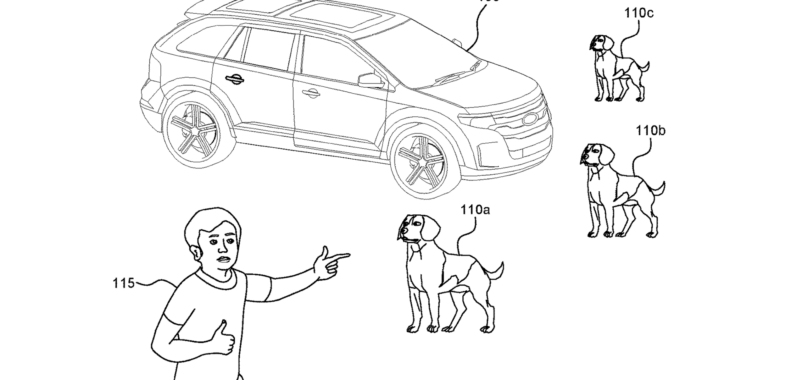Ford has a far-off vision of one day using holographic technology popularized in sci-fi to create digital representations of cops and guard dogs to deter would-be criminals. A recently published patent filing from the automaker details how multiple integrated holographic camera modules (IHCMs) could be used to create “moveable and interactive holograms” inside and outside of a vehicle. Though it’s unclear whether or not Ford will ultimately pursue holograms tech in its cars, the filling lays out numerous scenarios where these digital projections could be used to ward off unwanted visitors or simply place a virtual representation of a drive through menu inside a car for easier ordering. The patent also oddly includes the description of a massive hologram polar bear with its head sticking out of a car.
Holograms for security
Ford’s patent explores the use of holograms projected on both the exterior and interiors of a vehicle. For the exterior examples, the flings include illustrations of what looks like digital police officers standing beside a parked vehicle. The filing claims this hypothetical car could have multiple integrated IHCMs—which include cameras, projectors, and computing components—that would work in tandem to beam out a projection “without any noticeable distortions.” Drivers could initiate the hologram system, the filing notes, by looking at the car and giving a “thumbs up.” The patent was originally filed in February 2023, but was published and made public late last month and first spotted by Ford Authority.

Broadly, holograms are created by using a reflecting laser and light waves to project an image onto the surface. The result of this practice is an image that appears three dimensional to a viewer without the need for special viewing equipment. In the real world examples of holograms are most commonly seen on the back of currency and credit cards. The technology attracted mainstream interest in 2012 when an apparent “hologram” of the late rapper Tupac Shakur appeared onstage at Coachella. In reality, the 2D image on display didn’t actually use holography at all. But others are trying to make it work. Google is currently using a version of this technology to create a first-of-its kind holographic virtual conferencing tool. Ford’s patent, in particular, does not spend much time diving into the underlying tech powering holograms system. Instead, it focuses on detailing a “system and method” for possibly delivering the projections through a vehicle.
So, why would someone want a hologram lounging outside their car? In theory, according to the patent, a realistic looking police officer hologram could act as a form of deterrence. If an individual were to touch or walk through the hologram, an alert could be sent to the vehicle’s owner. The vehicle would come loaded with an inventory of pre-stored holographic images. One of the illustrations shows what looks like a holographic guard dog, presumably used to patrol a vehicle. It almost seems like the digital equivalent of the growling junkyard dog, though the dog in Ford’s drawing isn’t exactly what you would call intimidating.
Inside, the filling suggests holograms could be used to show virtual representations of a drive through menu or pull up movie listing times within the cabin of the vehicle. The filing also suggests smaller holograms could appear on multiple surfaces within the vehicle, such as interior screens or even hovering atop mirrors. These holograms, in theory, could be used to make video calls, enhance an infotainment system, or even project guiding lines to aid with tricky parking maneuvers. In some cases, the exterior and interior holograms could be combined to create one large digital image. The patent bizarrely describes this scenario with the example of a massive polar bear hologram sitting in a car’s driver seat. The bear’s virtual head, too big to fit inside the car, protrudes out the top of the sunroof.

This isn’t Ford’s first foray with holograms. The company previously filed a patent for another proposed feature that would reportedly spray water mist into the air and then have a projector display an image over top of it. Ford did not comment when Popular Science asked whether it’s planning to implement holographic technology into any upcoming models. Instead, they provided this statement which applies to patent filings broadly.
“Submitting patent applications is a normal part of any strong business as the process protects new ideas and helps us build a robust portfolio of intellectual property,” a Ford spokesperson said. “The ideas described within a patent application should not be viewed as an indication of our business or product plans. No matter what the patent application outlines, we will always put the customer first in the decision-making behind the development and marketing of new products and services.”
The car industry has a long list of abandoned patents
Automakers have a long history of filing patents for zany technology doesn’t don’t always make its way to consumer vehicles. Recent patents from General Motors and Toyota show the car makers exploring an inflatable steering wheel with adjustable girth. Tesla, meanwhile, has looked into using lasers in place of windshield wipers. Other oddball car patents that never saw the light of day include an adhesive front hood that would snag-up struck pedestrians, a retractable wind-turbine for electric vehicles and, yes, an in-car urinal.

